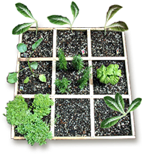By Joan Allen – Assistant Extension Educator – UConn Home & Garden Center
 A sustainable landscape incorporates a holistic approach of functionality, environmental stewardship, social responsibility and economic sensibility. These principles are tied together in the design and maintenance of a landscape in order to maintain and preserve natural ecological habitats.
A sustainable landscape incorporates a holistic approach of functionality, environmental stewardship, social responsibility and economic sensibility. These principles are tied together in the design and maintenance of a landscape in order to maintain and preserve natural ecological habitats.
Your Landscape Impacts The Environment
Principles put into practice in the home backyard can have significant impacts regionally and beyond. By reusing, recycling and reducing out inputs into the environment, we make our small piece of the world a better place to live and also positively impact global changes. Efforts to preserve forests and farmlands, reduce air pollution by decreasing fossil fuel consumption, and improve the water quality of our streams, rivers, lakes, and oceans will foster and protect biological diversity.
Small individual changes in how we live or in the way we care for the home landscape may seem inconsequential, but add up to make a real difference. Incorporating some of the following tactics into your lawn and landscape practices will reduce your impact on the immediate environment and on global climate change as well.
- Reduce the size of the home lawn,
Put some of the lawn area in plantings of native trees and shrubs. - Mow less often.
Let grass reach 3 inches in height and then remove the top 1 inch. - Leave grass clippings on the lawn.
They will increase the soil organic matter and supply one-third of the nutrients the lawn needs. - Hand-rake leaves instead of using power equipment.
- Compost yard waste.
Use as a source of organic matter and plant nutrients. - Have your soil tested and apply fertilizer according to recommendations.
UConn offers inexpensive soil testing with easy-to-read results and recommendations. - Support local growers and garden centers.
Shop at garden nurseries that grow native or regionally-adapted plants rather than purchasing from suppliers that ship in their stock from out of state. - Plant a variety of native and non-invasive ornamentals.
This will encourage a greater diversity among the natural insect pollinators, predators and bird populations. - Plant trees to shade the house reducing air conditioning usage and costs.
- Conserve and limit water use in the landscape.
- Redirect water runoff from impervious surfaces
From areas such as roads, walkways and driveways to vegetated swales or buffer areas. - Use rain barrels to capture water from roof tops and gutters. Apply on non-edibles.
- Connect a rain sensor to home irrigations systems.
- Water plants less frequently.
But water deeply to encourage a deep and extensive root system.